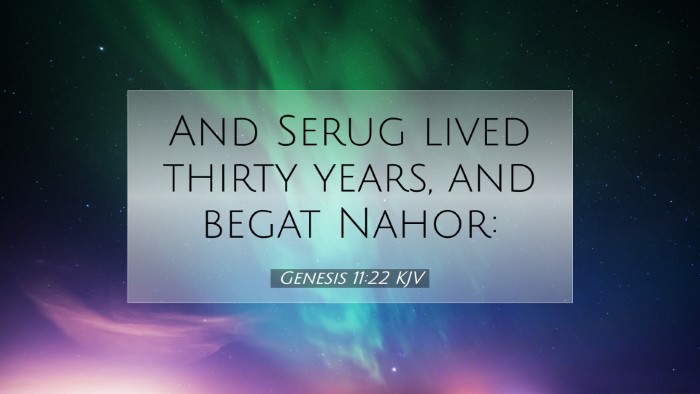Commentary on Genesis 11:22
Verse: "And Serug lived thirty years, and begat Nahor." (Genesis 11:22)
Introduction
The genealogy outlined in Genesis 11 serves a vital purpose in establishing the lineage leading to Abraham, a significant figure in biblical history. It highlights God's providence in preserving a line through which His covenant would eventually be manifested. Here, we focus particularly on Serug, his life, and the implications of his fatherhood.
Historical Context
Serug is part of the post-Flood genealogy which stretches from Shem to Abraham. Each generational record serves as a thread in the tapestry of biblical history, linking significant events and figures in a coherent narrative of humanity's relationship with God.
Exegesis of the Text
Matthew Henry's Commentary: Henry emphasizes the brevity of the records in these genealogies, noting that while Serug's lifespan is mentioned, little else is elaborated. This serves the purpose of highlighting the unfolding plan of God toward Abraham, the Hebrew patriarch. The naming of Nahor establishes important continuity in God's covenant people.
Albert Barnes' Notes: Barnes notes that the age of Serug at the birth of Nahor was thirty years, a relatively young age by the standards of genealogies which often note longer generational spans. This may reflect the socio-cultural context of the time, where early marriage was common among the descendants of Shem.
Adam Clarke's Commentary: Clarke provides insight into the meaning of the names and their possible implications. He explains that the name "Nahor" is significant as it identifies not only a person but plays a role in the ongoing narrative of God’s chosen lineage. The name is of Hebrew origin, potentially linked to "snorer," perhaps reflecting characteristic traits or attributes that were meaningful in a historical context.
Theological Implications
This verse may seem simple, but it points to vital theological truths. The mention of Serug and the birth of Nahor reinforces the theme of divine purpose in family lines. Every name is significant, suggesting that history is moving towards a decisive moment in God's plan.
The Covenant Lineage: Serug is part of the lineage that leads to Abraham, the father of many nations. This genealogy affirms the faithfulness of God who continues His covenant through generations. The significance of this passage lies not just in the names mentioned but how they highlight God’s redemptive purpose for humanity.
- God's Sovereignty: Each name embodies God's sovereign will in selecting a line through which He acted historically and redemptively.
- Importance of Generations: The passage reflects on the importance of heritage and legacy within families, emphasizing how key figures are raised up in due time for God's purposes.
Application for Contemporary Readers
For pastors, theologians, and students, Genesis 11:22 serves as a reminder of the importance of legacy in our spiritual journeys. Just as Serug fathered Nahor, contemporary believers are encouraged to consider how their lives influence the next generation.
- Reflect on Spiritual Heritage: Believers should examine their spiritual heritage and be intentional in nurturing the faith of the next generation.
- Importance of Naming: Names carry significance. Encouraging the use of biblical names or descriptors can promote a sense of identity rooted in faith.
- Recognizing God's Hand in Lineage: Understanding the sovereign hand of God in every generation encourages believers to trust in God's unfolding plan even when they cannot see it.
Conclusion
Genesis 11:22 may appear as a mere genealogical marker, yet it encapsulates profound theological truths and reflections on God's covenantal faithfulness. The legacy of Serug, and the birth of Nahor, remind us that God is intricately involved in human history, shaping it for His redemptive purposes. As we reflect on these verses, may we seek to honor our spiritual heritage and pass on the faith diligently, ensuring that God's work continues through us.


